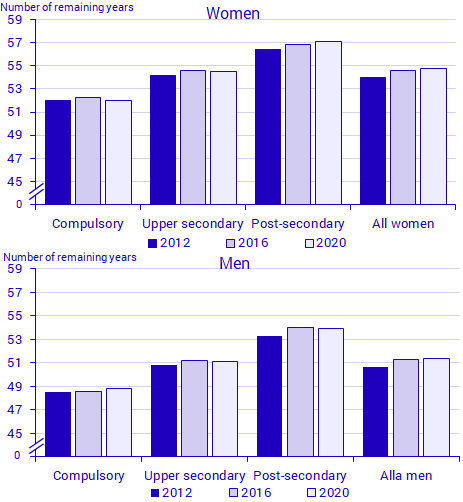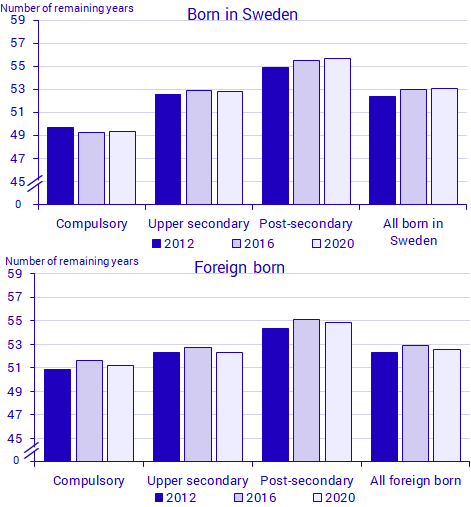Remaining life expectancy, by level of education
Life expectancy decreased in most groups in 2020
Statistical news from Statistics Sweden 2021-06-04 9.30
Between 2012 and 2019, life expectancy increased in all education groups, while in 2020 life expectancy fell and in some groups was lower than in 2012.
Average life expectancy is higher among women than among men, higher for co-habiting persons than for single persons, and higher for those with a longer education compared with those with a shorter education. Life expectancy has increased steadily for both women and men. The same applies in most other countries. However, in 2020, life expectancy decreased as a result of a large number of deaths due to COVID-19.
In 2020, remaining life expectancy at 30 years was 54.7 years for women and 51.4 years for men.

Compared with 2012, life expectancy at 30 years has increased by 0.7 years for both women and men. However, in 2020, life expectancy fell for both women and men compared with the previous year. This decline was noted among groups with compulsory education, upper secondary education, and post-secondary education. The reason for the decline was the high mortality rate in the wake of COVID-19. Among women with compulsory education and upper secondary education and among men with compulsory education and post-secondary education, life expectancy in 2020 was somewhat lower than in 2016. Life expectancy for all women and men in total was still somewhat higher in 2020 than in 2016. This is mainly due to the fact that an increasing proportion of the population has post-secondary education.
There are clear differences in life expectancy between groups with different levels of education. Life expectancy is a few years higher for people with upper secondary education than for those with compulsory education and life expectancy is a few additional years higher for those with post-secondary education than for those with upper secondary education. In the period from 2012 to 2020, the differences between the groups increased somewhat, for women in particular. This is mainly because since 2012, life expectancy for women with post-secondary education has increased clearly, but not for women with upper secondary education and with compulsory education. In 2020, the difference between the groups with post-secondary education and with compulsory education was just over 5 years for both women and men. The difference in life expectancy between those with post-secondary education and with upper secondary education was 2.6 years for women and 2.8 years for men, which is a somewhat larger difference for both sexes than in 2012.
Larger differences for persons born in Sweden
Life expectancy is roughly the same for persons born in Sweden and for foreign born persons in the groups with upper secondary education and with post-secondary education. However, in the group with compulsory education, life expectancy is clearly higher for foreign born persons than for persons born in Sweden.

There are clear differences in life expectancy based on the level of education for both persons born in Sweden and foreign born persons. In the period from 2012 to 2020, life expectancy for persons born in Sweden with compulsory education and upper secondary education has remained virtually unchanged, while it has increased for people with post-secondary education. Among foreign born persons, this change has been more evenly distributed, regardless of level of education. In 2012, the difference between the groups with the highest and the lowest life expectancy was 5.2 years for persons born in Sweden and 3.5 years for foreign born persons. In 2020, this gap had increased to 6.3 years for persons born in Sweden and 3.7 years for foreign born persons.
In 2020, it was possible to see some differences in how much life expectancy declined compared with the previous year. The decline was considerably larger for foreign born persons than for persons born in Sweden. Life expectancy for foreign born persons in the various education groups was 0.3 years to 0.5 years less in 2020 than in 2016. For persons born in Sweden, life expectancy was lower in 2020 than in 2016 only for people with upper secondary education.
Publication
These statistics are published as complete life tables from 30 years in the Statistical Database on Statistics Sweden in the following tables 2012–2020:
Länk till SSD- för följande tabeller
- Education level, region of birth (Swedish born and foreign born), sex, year and age
- Education level, household type, sex, and age (limited to the population born in Sweden)
- Level of education, county, sex, five-year period and age (limited to the population born in Sweden)
These statistics are also published in tables and figures with comments on remaining life expectancy at 30 years and at 65 years.
Definitions and explanations
Average remaining life expectancy is normally referred to as “life expectancy”. This is an index that described mortality in all ages for a year or a specific period. Mortality is shown in a life table and the average number of years remaining is calculated for all ages. Here, the number of remaining years is calculated from the age of 30 years.
The statistics refer to persons aged 30 years and older who were registered in the population between 2011 and 2020.
These statistics have been produced based on data in Statistics Sweden’s Population Register, Household Register, and Education Register.
Feel free to use the facts from this statistical news but remember to state Source: Statistics Sweden.
